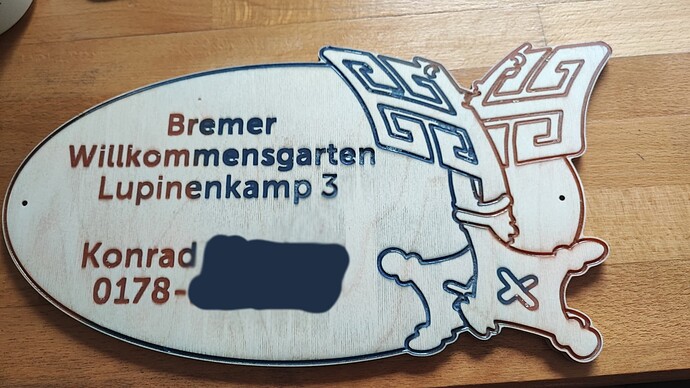First time working with epoxy. There are a few bubbles and in some places I didn’t pour enough, also the wood sucks and absorbed a lot of it outside the letters, but eh, good enough. 
in working with epoxy, I have found that if you do a clear coat (any type will work I usually us a cheep rattle can) on the wood and let it dry, it will prevent the bleeding. It will seal the wood so it can’t absorb and of the epoxy (or paint for that matter), and not let it bleed.
so a clear coat first, then machine, then do colours?
Cut, clear, color…that’s how I do it. If it is particularly crappy wood that may have a bit of chip-out, I may clear first as it “can” help harden up some of those fibers and prevent that chip out on the surface. Then cut, clear color.
But if I poured clean first, I could not pour colours in the gaps, can’t I? Or do I do it like, very thin?
My apologies if I wasn’t super “clear” in the process. I use a spray clear coat (like spray paint) on the wood. This will just put a very thin coat in your gaps that would seal the wood. Then you pour your colored epoxy. This should prevent the issue of
An example of what I use for a clear coat:
You could also use lacquer or shellac. I know you are not in the U.S. so whatever your country has that is similar would work. Lastly, if you can’t get anything like that, then you can mix up a batch of clear epoxy and brush on a very thin coat of that and let it cure. This will do the same thing as the spray clear coat, leaving you enough of a pocket to fill with the colored epoxy.
This will also help with some of the overpour as it can be wiped up easier and not be absorbed into the wood right away.
Got it, thanks. ![]() I do have a spray can with clear coat.
I do have a spray can with clear coat. ![]()
That should do it. just a light coat or 2 should help with that color bleed on any wood. It is my goto process when I carve anything that will get painted or epoxied to ensure there is no bleeding of the color into the wood and keeps nice crisp lines.
The clear coat has to fill the tiny grain holes, right?
I do the same thing with spraying clear coat before color. Then i seal the color with another coat after. Works well.
You might even try a thinned clear epoxy if you’re going to brush it in. You can thin epoxies with either acetone or denatured alcohol. Thinning will help it absorb more deeply into the wood and once the thinner evaporates, you’re not left with such a thick coat of clear epoxy.
I haven’t tested for this application, but I’ve definitely thinned epoxy for other purposes!
For that matter, thinned epoxy is definitely used for hardening wood, often for wood with some decay in it. This might be useful for preventing the chipout that @c00nphrog mentioned.

